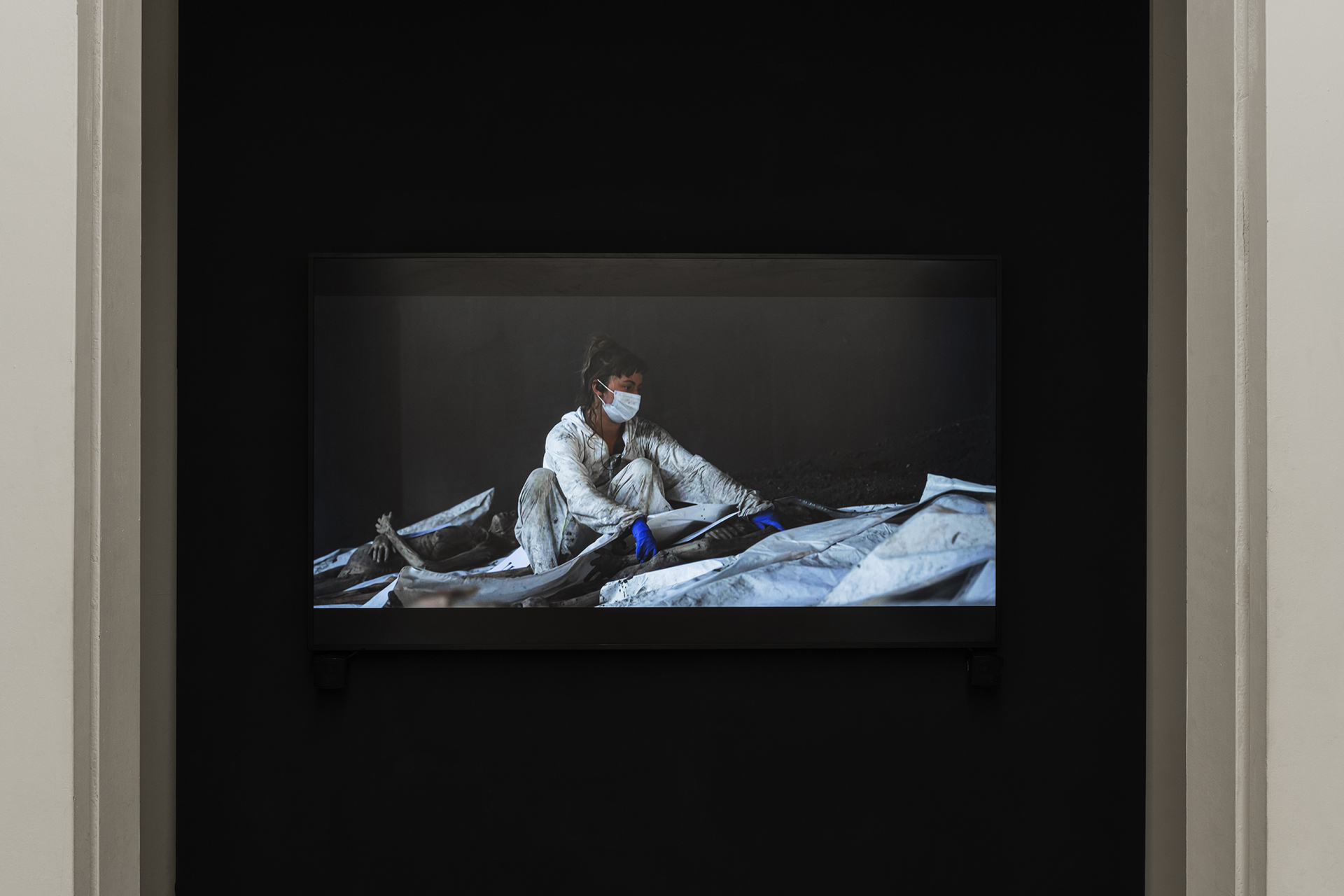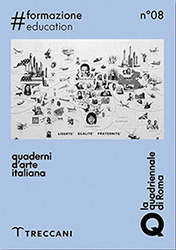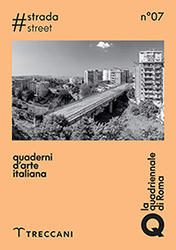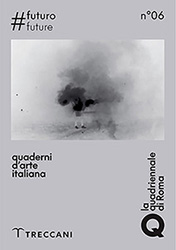Inhabiting the Margin
Cecilia Babolin
According to bell hooks, in order to free oneself from an oppressive regime it is sometimes necessary to isolate oneself and occupy a space on the edge of society: the margin. Marginalisation — be it real or symbolic — can become an opportunity to create new spaces of self-expression and self-redefinition using different canons. During the African-American writer’s childhood, growing up under a harsh regime of racial segregation, the safest place for her to take refuge was her grandmother’s house. For bell hooks, the home — of which the woman was supposed to be the guardian angel in a patriarchal society — turned out to be the site of resistance, where she could find herself as a human being, in the warmth of her family surroundings.[1]
As Romeo Castellucci suggests in a recent interview, exclusion from the community is the penalty paid by the tragic hero when they subvert the established order.[2] Yet, the same society that has excluded the marginalised person considers them as ‘alien’ — as something that cannot be identified or, therefore, commodified. They are an anomalous, dysfunctional subject, and thus perceived as a threat.[3] For centuries, the Christian and capitalist West has combated othernesses as deviant behaviour or as a harmful example, and has thereby cast those identities deemed unacceptable as monstrous creatures.[4] Hence the black slave consumed by drudgery is turned into a zombie, those who embrace non-heteronormative gender identities and sexual orientations become vampires, while the emancipated woman who rejects the ‘mystique of femininity’ is marked out as a witch.[5]
Once the other has been recognised as the enemy, its annihilation becomes an acceptable end. For example, it takes only the slightest foray into colonial literature to show Europe’s hatred for non-Western populations: they appear immature and primitive, as bodies devoid of intelligence that can be sacrificed for physical labour.[6] The slave, who is completely dehumanised by their exploitation, goes from ‘alienated’ in the Marxist sense to alien, or zombie.
The zombie is one of the many creatures, in various cultures around the world, suspended somewhere in-between life and death. Yet, it is the only one whose history is closely connected with slavery and colonialism. The cult of zombies, which had first developed in central Africa, arrived in Haiti via the Atlantic slave route, and this also changed its meaning. The zombie turned from being a — not necessarily malignant — spiritual entity that can transfer itself into objects or people, into the slave victim of a spell that leaves him unconscious and incapable of rebellion.[7] It was only from the second half of the 20th century — with Richard Matheson’s novel I am Legend and the movies of George A. Romero — that the zombie became a danger. From a living being in a catatonic state, the zombie evolved into a dead person who comes back to life — a cannibal with a possible contagious effect on the living.[8]
The Alterazioni Video collective recovered the Central African roots of the zombie with the 2009 short film All My Friends Are Dead. The artists follow anthropologist Ivan Bargna on an expedition to Bandjoun, Cameroon to film a zombie horror musical together with the Bamileke population.
Cinema — the tool that has since the 1930s done most to spread the racialised image of the zombie in popular culture[9] — is in this instance contaminated by other mediataken from the Internet. The film is the result of the active participation of the community, which here abandons the traditional role of the spectator.[10] Nor does it simply recite a script.[11] Rather, the community lays claim to the figure of the zombie, asserting its own identity and freeing itself from racial stereotyping.[12]
The practice of collective production and the consequent dropping of the notion of authorship; the intrusion of material originating from social networks; and the absence of a script or any plan for the work — these elements become the pivotal characteristics of the ‘Turbo Films’ produced by Alterazioni Video, of which All My Friends Are Dead represents the first experiment. Without doubt, the search for collaboration ‘from below’ ought to be set in connection to the working methods of the collective’s members themselves. They live in Italy, Berlin and New York and meet almost exclusively online, in the virtual space offered by the new technologies that can now be defined as public, just like the real public space in our cities, and which can give rise to new forms of political activism.[13] Any content published on the Internet immediately becomes public property, subject to continuous alteration and personalisation by whoever may lay their hands on it. The same has happened in the case of All My Friends Are Dead: several edits not made by the collective are circulating online, including ones far-removed from the original.[14]
Following Romero’s 1978 film Dawn of the Dead, in which the zombie and his typical cannibal bulimia became a metaphor for consumer greed in late capitalism, there have been many new political reinterpretations of this figure. The zombie, as a dead person who comes back to life, is a repressed that violently resurfaces — the unacceptable taboo of the corporality of death, which the contemporary West is no longer used to living with.[15] This is the same repressed that Nicolas Martino[16] talks about with regard to Romeo Castellucci’s Résurrection. Symphonie n. 2 Gustav Mahler, in whichhundreds of corpses are recovered following the tragic discovery of a gigantic mass grave.
The zombie, who has no identity, and who is never considered individually but always as part of a group, is the perfect representative of the masses. The strong connection between him and the world of work — not only that of the Haitian slave, but also that of the parcelled-out, repetitive, deskilled, dehumanised, factory or office worker — has already been a focus of critical attention.[17]
As with All My Friends Are Dead, cinematic fiction becomes a powerful glue for the community, almost as powerful as Greek tragedy was.[18] We see this in the case of Marinella Senatore’s NUI SIMU (2011). This short film shows the encounter between former miners from near Enna, Sicily and the younger generation, who are totally unaware of their own birthplaces’ past. They have been brought together in a theatre, on the pretext of organising casting for a film about the Sicilian mines. The former miners, many of whom are still illiterate, all began working in their early years, sacrificing their childhoods and their health. In this short film, Senatore gathers them around herself like a circle of wise men — the custodians of ancient knowledge which is to be passed on to the community. But from a certain point in the film, the artist disappears from the frame, leaving the former miners to carry on without her, so that they can tell their stories independently and share their memories with the young people listening.[19] Such a relinquishment of control over the work would later be crucial for Marinella Senatore also in the creation of the famous School of Narrative Dance: it emerged precisely as a result of her experience in Sicily, and proposed an idea of an alternative, nomadic, non-hierarchical pedagogy. In this case, too, the artist initiates the creative process, which then comes to life spontaneously through the collaboration of the various participants. Their number often include marginalised people or those belonging to minorities, who are attracted by the opportunity for social connection offered by the School, for instance through collective parties or protest demonstrations.[20] As Senatore herself relates, these ought to be considered site-specific works, in that they emerge within communities that are always different, with approaches and methods that are never quite the same.[21] As in the case of Turbo Films, they are developed on the basis of a given context (‘The location is half of the job: make sure you pick the right one. Let the location act itself out. Let it scream’[22] ) — and never from a detailed script.
In this perspective, even the cosmic space, which is without legal boundaries, and therefore without laws, is the place of inclusiveness in which the marginalised finds its place. This is what Afrofuturism teaches us, reinterpreting this space as a new diaspora’s field of action[23] — the exploration of the unknown which, historically, Western culture has experienced but which has been denied to the black population. The nomadic being, the alien par excellence, bears affinities with the tragic hero described by Castellucci: it is not, therefore, the person who romantically chooses such a life, but the one who is forced to migrate; in both cases, they are people who escape the meshes of the law and disturb the social order.[24] Nomadism is, moreover, a creative act: by giving up on every existing socio-symbolic category, from family to state to male dominance, one breaks down boundaries and walls to define new possibilities.[25]
In Pedro Neves Marques’s 2022 work Vampires in Space, the alien is also the extraterrestrial creature to whom we are so accustomed: five vampires (one cisgender woman and four transgender women) try to free themselves from the melancholy typical of their species and set off to discover the skies. The cosmonauts leave Earth for another planet, but only in space do they recognise their ideal living conditions: here, the Sun does not rise, there is no light, and the natural alternation of day and night does not exist. This is an eternal night, like the eternity of their suspension between life and death: the same existential condition of ‘hanging in the balance’ experienced by those who transgress and destroy gender binarism. As they move away from planet Earth, these astro-travelling women also leave behind them the centuries-old prejudice that associates vampirism with sexual depravity[26] and epidemics, from the plague in the modern era to AIDS in more recent decades.[27] It is important to remember that AIDS has long been associated with the queer community, particularly gay men and transgender women, as revealed by the acronym ‘GRIDʼ, which stood for Gay-Related Immune Deficiency.[28]
The notorious aspect of the vampire — the bad reputation of a figure present even in Karl Marx’s Das Kapital as a metaphor for capitalist parasitism — endures in Andrea Mastrovito’s NYsferatu — Symphony of a Century (2017), albeit with a different nuance. Here, the vampire protagonist is the economic migrant, the political refugee,[29] who has just landed in New York and brings with him the curse of the war which he has just escaped.
During the film Vampires in Space, we see one of the protagonists reading a volume from New Mutants, the comic book series published by Marvel Comics, which focuses on the adventures of young mutant superheroes. This detail not only provides another comparison with the condition of transgender people, but can also help us to introduce science fiction as a subject of investigation in Pedro Neves Marques’s work. Indeed, this is his great interest, along with anthropology. Citing the anthropologist Anna Tsing, for Neves Marques otherness is a colonial invention designed to legitimise the conquest of newly discovered lands — an otherness of which we find continuing traces in the fantasy literature of the modern era and, later, in science fiction.[30]Another theme dear to the artist’s heart is the questioning of heteronormativity, as a sexual orientation, a social glue and a form of disciplining bodies. The figures who populate Neves Marques’s videos experience sentimental relationships that go beyond the classic heterosexual couple, as they explore the possibilities that science and biology can offer their bodies and as they try to tear down even the most hard-to-overcome taboos such as male pregnancy. This latter appears, for instance, in the short films A Morbida (The Bite),from 2018, and Becoming Male in the Middle Ages,from 2022. The myth of male pregnancy — which probably originated in the context of Japanese manga and spread on the Internet thanks to short stories, amateur novels and fan art — fascinates the artist as a possible solution to infertility and as a means to finally free the female body from the social duty of reproduction. But, at the same time, it risks re-asserting within same-sex couples the same-old heteronormative pattern based on the traditional family.[31]
Another instance of nomadic, hybrid, and alien creatures are the so-called ‘donne di fora’. These figures in Sicilian folklore are similar to witches and, for this reason, were long persecuted in Spanish-ruled Sicily — but they still survive in popular memory. They can be understood as foreigners but also as ‘out of their minds’, polymorphous beings from the standpoint of their gender and species. But ‘fora’ (‘outside’) also stands for the outside space: according to some sources, the ‘donne di fora’ were emancipated, went out at night to explore magical places, dance, and feast.[32] These women, like many others accused of witchcraft, thus rejected the domestic dimension and the role of wife and mother expected by society, choosing instead an inactive and erratic life that in turn prompted the repression against them.[33]
In Elisa Giardina Papa’s work ‘U Scantu’: A Disorderly Tale (2022), the ‘donne di fora’ are depicted as young women riding in groups on bicycles equipped with large speakers for playing music. They live occupying the utopian architecture of Gibellina Nuova, the town built after the earthquake of 1968, which destroyed the ancient village and killed many of its inhabitants. The ambitious reconstruction project for creating a modern ideal town recruited many artists and architects, but work did not start until 1972, after many of the displaced people had already resigned themselves to moving elsewhere, taking advantage of free train tickets and the facilitated passport procedures exceptionally granted by the Italian state. The spaces of the new town took shape slowly, with long interruptions and then moments when work was restarted (Alberto Burri’s ‘Grande Cretto’, finally inaugurated only in 2015, is the most emblematic example). Not all projects were completed or fully respected, and not always did the few remaining inhabitants welcome the final result, which was at times labyrinthine and little-coherent.[34] In ‘U Scantu’, Franco Purini and Laura Thermes’s deep perspective of sun-drenched porticoes and Ludovico Quaroni’s monumental white sphere for the Chiesa Madre are transformed into the lair of the ‘donne di fora’; the ghostly, silent city is invaded by music, racing bicycles, and non-conforming bodies that would have found no place elsewhere.
The condition of women and the evolution of labour in the capitalist system are among the main themes of many of Elisa Giardina Papa’s works: in the bibliography indicated by the artist herself as the source of inspiration for ‘U Scantu’,[35] we find Silvia Federici’s text Caliban and the Witch. Women, the Body and Primitive Accumulation. This work considers witch hunts as an institutional response to the contemporary demographic and economic crises between the 16th and 17th centuries, thus demonstrating how the definition of gender roles and the consequent domestic confinement of women were the result of an invention that took place during the formation of modern capitalist society.
Giardina Papa has collaborated with Alterazioni Video on several projects, and has in common with this collective her use of the Internet as a means of research and as a tool for expression. But they also have a shared focus on the social ties that are created online and in real space. In 2009, together with the collective, Giardina Papa organised the playful participatory action Il carrellino d’oro, an obstacle race to transport parcels with a goods trolley along Milan’s Via Paolo Sarpi — an area known for its many Chinese-owned businesses, who are not always on good terms with city hall.[36]
In Technologies of Care (2016), the artist collects the testimonies of four women who use the Internet and new technologies for remote working. As the title suggests, these new digital professions are in fact different types of care work that have historically associated with the female sphere, such as customer service, the sharing of erotic content, and offering interactions on social networks or in various instant-messaging systems. Many of these women live in countries that are going through serious economic crises, and digital work allows them to earn money easily. They can do this without being forced to migrate and even as they maintain their anonymity (which also allows them not to reveal their gender and, consequently, not to suffer sexual harassment or sexist discrimination such as the gender pay gap), but they also have to go without any trade-union or legal protection. Works such as Technologies of Care, or indeed Cleaning Emotional Data (2020) — an investigation into the Artificial Intelligence databases created to recognise human emotions — reveal how the web has quickly outgrown its initial utopian phase, based on the free exchange of information and sociability, to become a closely guarded territory dominated by ruthless capitalist logics.[37]
Rosi Braidotti has shown how the Western culture born of Humanism — an anthropocentric and positivist culture — was, in reality, remarkably exclusionary, racist, chauvinist, and classist, to the extent of producing phenomena such as capitalism and colonialism.[38] In contemporary Western society, human relations have been desertified: today’s incessant work rhythms take away the time to nurture friendships and form political networks, and this has the effect of crumbling local communities into small family units, often dominated by patriarchal logics.[39] Precisely for this reason — and contrary to the canonical representation in which the tragic hero acts alone — bell hooks sought the creation of strong bonds of affection that would make it possible to survive, endure and resist in the margins.
Indeed, the examples here show how small, precarious communities of oppressed individuals have found their home on the margins of the world that rejected them. Nostalgia is a luxury they cannot afford, after centuries of persecution: regretting the past is unthinkable, while the future is still to be created.
[1] b. hooks, Yearning: Race, Gender, and Cultural Politics, South End Press, Boston 1998.
[2] R. Castellucci in G.M. Tosatti, The scorching object A conversation with Romeo Castellucci, in “Quaderni d’arte italiana” no. 2, #popular, June 2022, <https://quaderni.online/en/the-scorching-object/>.
[3] Men in Red, Ufologia radicale. Manuale di contatto autonomo con extraterrestri, Castelvecchi, Rome 1999.
[4] Cf. R. Braidotti, Madri, mostri e macchine, Manifestolibri, Genoa 2005.
[5] B. Friedan, The Feminine Mystique, Dell Publishing, New York 1974.
[6] Ever since the first Spanish colonisation of the Americas, racism has played a central role in justifying the extermination or enslavement of Native Americans. This demonisation has especially drawn on the circulation of macabre and scabrous stories about Native Americans’ customs, such as cannibalism and sexual depravity, or by seeking a confirmation of their presumed inferiority from sacred texts, for instance speaking of their satanic line of descent. In the eighteenth century, when the slave trade from Africa to the Americas reached its peak, an early abolitionist movement emerged. Yet this was opposed by some of the most famous Enlightenment philosophers such as Voltaire — the supporter of a racial theory according to which some were naturally inclined to be enslaved because of their docile temperament and feeble minds. Finally, with the birth of modern anthropology in the nineteenth century, racism experienced a new legitimisation thanks to evolutionary theories. See G. Gliozzi, ed., La scoperta dei selvaggi. Antropologia e colonialismo da Colombo a Diderot, Principato Editore, Milan 1980; A. Burgio, Il discorso razzista come giustificazione dello sfruttamento, < https://www.machina-deriveapprodi.com/post/il-discorso-razzista-come-giustificazione-dello-sfruttamento-e-dell-esclusione-sociale >
[7] L. Maltz-Leca, De-animazione: un indice zombie della dimenticanza, in (multiple authors) Andrea Mastrovito: To Draw Is To Know, Magonza Arezzo 2023, pp. 120-127.
[8] M. Coulombe, Piccola filosofia dello zombie, o come riflettere attraverso l’orrore, Mimesis Edizioni, Milan-Udine 2014.
[9] Ibid.
[10] J. Rancière, The Emancipated Spectator in “Artforum”, vol. 45, no. 7, March 2007, < https://www.artforum.com/features/the-emancipated-spectator-175248/ >.
[11] V. Catricalà, TechnoPop. Oltre l’artista, verso l’artista, in “Quaderni d’arte italiana” no. 02, #popolare, June 2022 < https://quadriennalediroma.org/technopop/ >.
[12] H.K. Bhabha, The Location of Culture, Routledge, London, 2012.
[13] G. Pellicari, Spazio pubblico, immaterialità e fruizione online. Alterazioni Video ad Augmented Place, in G. Bartorelli, ed., Augmented Place. L’arte aumenta la realtà, exhibition catalogue, Galleria e Piazza Cavour, Padua, 8 November – 9 December 2012, CLEUP, Padua 2012.
[14] Alterazioni Video, The Africans Turbo Films: All My Friends Are Dead and Turbo Anthropology and M. Lucchetti, Shitstorm Kings, in Turbo Films: All My Friends Are Dead and Turbo Film Anthropology, Alterazioni video (ed.), Logo Fausto Lupetti, Bologna 2016.
[15] A. Lucci, Metafore della non-morte. Riflessioni culturologiche sul potenziale metaforico della figura dello zombie in ‘tròpos’, year IX, no. 1, 2016.
[16] N. Martino, Res gestae. Il sentimento tragico della storia nell’arte italiana del XXI secolo, https://quadriennalediroma.org/wp-content/uploads/2024/01/Q_Paesaggio_NicolasMartino.pdf.
[17] A. Lucci, Metafore della non-morte, cit.
[18] G.M. Tosatti, The scorching object, cit.
[19] Tenley Bick’s interview with Marinella Senatore, 4 December 2020 < https://www.youtube.com/watch?v=c2xdzigErhA >
[20] S. Carbone, Marinella Senatore. Le forme dell’epimero e la costruzione di comunità, in “roots§routes. Italianità”, year VI, no. 23, December 2016 < https://www.roots-routes.org/marinella-senatore-le-forme-delleffimero-la-costruzione-comunita-serena-carbone/ >
[21] G. Ludovici, The School of Narrative Dance: corpo, movimento, partecipazione e fioritura. Intervista con Marinella Senatore in “roots§routes. L’educazione nel corpo. Per una somatica della relazione pedagogica”, year XI, no. 36, May – August 2021, < https://www.roots-routes.org/the-school-of-narrative-dance-corpo-movimento-partecipazione-e-fioritura-intervista-con-marinella-senatore-di-ginevra-ludovici/ >
[22] Alterazioni Video, The Turbo Film Manifesto, in Alterazioni Video, Turbo Film and the Uncertain Future of Moving Image, cit.
[23] C. Attimonelli, Genealogie dell’Afrofuturismo: la black sci.fi per finirla con l’Umanesimo, in “roots§routes. Afrofuturismo. Spazi, corpi, immaginari, estetiche, pensiero dell’afrotopia”, year IX, no. 31, September-December 2019, < https://www.roots-routes.org/genealogie-dellafrofuturismo-la-black-sci-fi-per-finirla-con-lumanesimo-di-claudia-attimonelli/ >
[24] R.J.C. Young, Introduction to Postcolonialism, Oxford University Press, Oxford 2001.
[25] R. Braidotti, Nuovi soggetti nomadi, edited by Anna Maria Crispino, Luca Sossella editore, Rome 2002.
[26] R. Dyer, Children of the Night: Vampirism as Homosexuality, Homosexuality as Vampirism in G. Williams, ed., The Gothic, Documents of Contemporary Art, Whitechapel and MIT Press, London and Cambridge, Massachusetts, 2007.
[27] V. Teti, La melanconia del vampiro, Manifestolibri, Rome 1994.
[28] L. Bernini, Le teorie queer. Un’introduzione, Mimesis, Milan-Udine 2017.
[29] N. Martino, Res gestae, cit.; C. Slanar, Animazione come agentività: a proposito di NYsferatu – Symphony of a Century and I Am Not Legend by Andrea Mastrovito, in (multiple authors) Andrea Mastrovito: To Draw Is To Know, cit. pp. 102-105.
[30] P. Neves Marques, If Futurity Is the Philosophy of Science Fiction, Alterity Is its Anthropology, in Sven Lutticken, Eric De Bruyn, eds, In Futurity Report, Sternberg Press, Berlin 2020 <https://www.pedronevesmarques.com/texts/PedroNevesMarques_IfFuturityIsThePhilosophyofSFAlterityIsItsAnthropology_FuturityReport_SternbergPress_2019.pdf >
[31] P. Neves Marques, Male Pregnancies, Exowombs, and the Meltdown between Hetero – and Homonormativity in In The Stomach and the Port: Liverpool Biennale Reader, Liverpool, 2021< https://www.pedronevesmarques.com/texts/PNM_Mpregexowombsandthemeltdownbtwnhetero%20homonormativity_liverpoolbiennial_2021.pdf >
[32] C. Geremia, Lo strano caso delle streghe di Sicilia: donne de fora, streghe, fate e guaritrici (XVI-XIX sec.), in “ILCEA” no. 45, 2022 < https://journals.openedition.org/ilcea/14529 >
[33] S. Federici, Caliban and the Witch. Women, the Body and Primitive Accumulation, Autonomedia, New York 2004.
[34] C. Costanzo, Gibellina. Memoria e utopia. Un percorso d’arte ambientale, Marsilio, Venice 2022
[35] < https://www.labiennale.org/it/arte/2022/il-latte-dei-sogni/elisa-giardina-papa >
[36] F. Guerisoli, The Collective Body Notes on Milan in the Early 2000s in “Quaderni d’arte italiana” no. 4, #identity, December 2022, < https://quaderni.online/en/the-collective-bodynotes-on-milan-in-the-early-2000s/> (last accessed 18 July 2024).
[37] T.H. Hui, How AI Manufactures a Smile: Tung-Hui Hu Interviews Artist Elisa Giardina Papa on Digital Labor in “Media-N”, vol. 16, no. 1, Spring 2020, < https://www.researchgate.net/publication/340067837_How_AI_Manufactures_a_Smile_Tung-Hui_Hu_Interviews_Artist_Elisa_Giardina_Papa_on_Digital_Labor >
[38] R. Braidotti, Il postumano. La vita oltre l’individuo, oltre la specie, oltre la morte, DeriveApprodi, Rome 2014.
[39] N. Fraser, Cannibal Capitalism: How our System is Devouring Democracy, Care, and the Planet – and What We Can Do About It, Verso Books, London-New York 2023.





